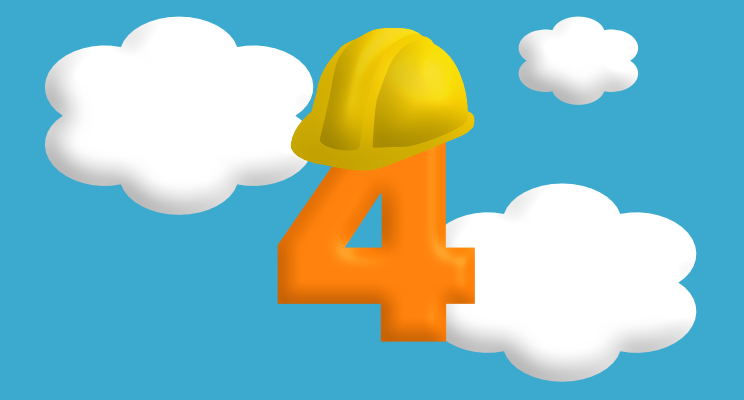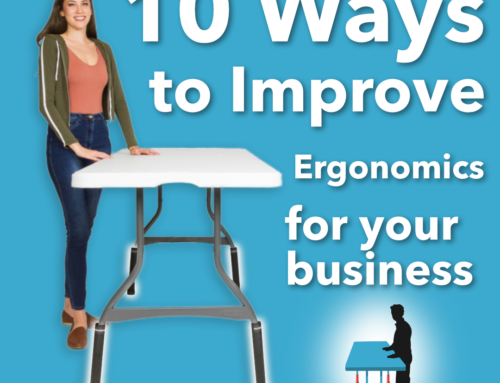June is National Safety month, and we love helping our readers, prospects, and clients stay safe at work! Here are some quick strategies to keep you safe and healthy.
1. Work ergonomically
This is the big one, and it applies no matter what kind of work you do or where you do it. If you work at a computer, make sure the screen is at the right height whether you’re sitting or standing. (Need help lifting your folding table surface to the right height when you’re standing? We got you covered.)
Laptops are not ergonomic, so add monitors, keyboards, and mice. The traditional rollerball mouse may not be great for you, so look into some other options that keep your wrists straight and your elbows close to your body when you’re using them.
If you’re standing, make sure the work surface is at the right height so your elbows are bent 90 degrees while you’re working and your head and neck are straight.
If you’re sitting, elbows and knees should be at 90 degrees with your feet flat on the floor. Use a footstool if necessary and adjust the height of your chair relative to your work surface.
Keep all your frequently used tools within easy reach so you’re not stretching or reaching to grab them on a regular basis.
2. Clear up trip hazards
We all have a tendency to leave cords where they can easily be tripped over, especially while working from home. Tape them down if you can, or make sure it’s clear where they are so no one trips over them. Likewise, clear pathways of obstacles and make sure steps are illuminated in some way.
Also take a look at your carpets and rugs when you’re working from home. If they’re damaged they might present a trip hazard, and similarly if they present an uneven surface to walk on.
Make sure you’ve got enough lighting on the subject! In addition to a desk lamp, you may need some overhead lighting. Your desk lamp needs to be bright enough for you to see easily, and bright enough lights in the rest of the room will help you avoid more tripping hazards.
Close your desk drawers when you’re at work. Leaving them hanging open is an invitation to trip for anyone who’s not paying attention.
3. Clean up spills
Spills are a common instigator of slips and falls, so don’t rely on non-skid shoes. If the spill is small enough, and it’s something not particularly dangerous like water or soda, you can just wipe it up.
But if it’s a bigger spill, and/or the liquid is something dangerous like bleach or workplace chemicals, make sure that you follow the correct steps of the 4 Cs.
- Communicate
If you’re by yourself and there’s no one around physically, you may not need to communicate. However, if you’re at home and there are family members present in other areas of the house or you’re onsite with members of the team nearby (including your supervisor), you need to let them know that a spill has happened.
- Control
Make sure it can’t get any worse. If a container is on its side, put it right-side-up. Close valves or anything else that will help stop the spill from becoming worse. Put on personal protective equipment (PPE) when necessary.
- Contain
Make sure the spill can’t go anywhere else, by neutralizing or spreading absorbent material on it.
- Clean
That may be collecting the absorbent material in a bag or a special drum or pail for dangerous chemicals, sweeping up (you might need to get rid of the broom entirely afterward) and so on.
You’ll then need to clean the surface that the spill was on, which could be with a bleach solution, detergent, or whatever’s appropriate for the material. Wash your hands afterward, and if your clothes are contaminated, get rid of them.
4. Use tools for lifting
So many people hurt their backs while lifting things that are too heavy, or twisting their backs while they lift. Don’t let that be you or someone who works for or with you!
If the load is actually safe for you to lift, as always, use your legs and not just your back to lift. Get as close as you can to it and keep your back as straight as possible when lifting – don’t twist. Bend at the knees, not your hips.
Many loads won’t be safe for you to lift, so use pushcarts, dollies, hand trucks, and similar tools to make sure it’s not just you handling the load. If you have certification for a fork truck, you can use those as well.
If you need a team lift, use a team lift. Waiting a few minutes for someone else to be available is a lot better than hurting your back because you tried to lift something you shouldn’t.
Do you have team members who need to stand at folding tables to work? Lift the surface of the table so they can work ergonomically instead of crouching which can lead to back pain and injuries (and OSHA recordables, worker’s comp costs, and all the rest of the expenses…) Click here to see our full product line of folding table risers.
Lift Your TableⓇ… SAVE YOUR BACK!




